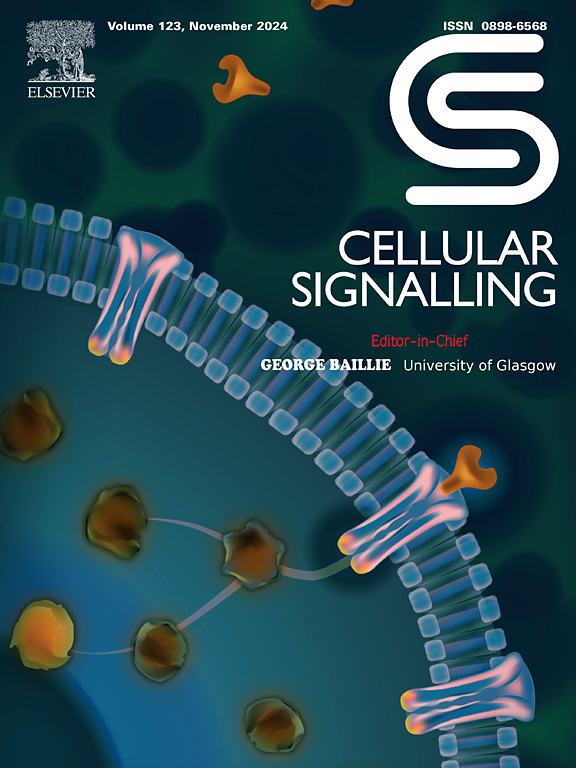Histone H4K12 lactylation promotes malignancy progression in triple-negative breast cancer through SLFN5 downregulation
IF 4.4
2区 生物学
Q2 CELL BIOLOGY
引用次数: 0
Abstract
Lactylation, a newly identified post-translational modification, is uncertain in its implication in triple-negative breast cancer (TNBC). In this study, we analyzed 60 TNBC samples using immunohistochemical staining and revealed elevated levels of pan-lactylated proteins and specific histone H4K12 lactylation in tumor tissues, correlating with TNBC progression. Lactate exposure in TNBC cell lines significantly induced lysine lactylation at the H4K12 site, leading to alterations in gene profiles and reduced apoptosis. These effects were attenuated by DCA or sodium Oxamate, inhibitors of endogenous lactate production. Gene sequencing showed an increase in Schlafen 5 (SLFN5) expression in TNBC cells treated with Oxamate, contrasting with the effects of lactate exposure. Analysis of TNBC tissues showed a negative correlation between H4K12 lactylation and SLFN5 protein levels. Overexpression of SLFN5 countered the effects of lactate on apoptosis and tumor growth, highlighting its pivotal role in TNBC malignancy. CUT&Tag sequencing indicated that lactylated H4K12 potentially binds to the SLFN5 promoter region. Luciferase reporter assays further verified that lactate-induced suppression of SLFN5 promoter activity is mediated by wild-type H4K12, but not by its R or A mutants, verified by both in vitro and in vivo apoptosis detection in response to lactate and Oxamate stimulation. These results establish that H4K12 lactylation, induced by lactate in TNBC cells, specifically suppresses SLFN5 expression, contributing to TNBC malignancy. Our findings illuminate a critical histone lactylation-dependent carcinogenic pathway in TNBC.
组蛋白 H4K12 乳化通过 SLFN5 下调促进三阴性乳腺癌的恶性进展。
乳化是一种新发现的翻译后修饰,其在三阴性乳腺癌(TNBC)中的影响尚不确定。在这项研究中,我们使用免疫组化染色法分析了 60 例 TNBC 样本,结果发现肿瘤组织中泛乳化蛋白和特异性组蛋白 H4K12 乳化水平升高,这与 TNBC 的进展相关。TNBC 细胞系中的乳酸暴露会显著诱导 H4K12 位点的赖氨酸乳化,导致基因谱改变和细胞凋亡减少。内源性乳酸生成抑制剂DCA或草酸钠可减轻这些影响。基因测序显示,在使用草氨酸钠处理的 TNBC 细胞中,Schlafen 5 (SLFN5) 的表达增加,与乳酸盐暴露的影响形成鲜明对比。对 TNBC 组织的分析表明,H4K12 乳酸化与 SLFN5 蛋白水平呈负相关。SLFN5的过表达抵消了乳酸盐对细胞凋亡和肿瘤生长的影响,突显了它在TNBC恶性肿瘤中的关键作用。CUT&Tag测序表明,乳酸化的H4K12可能与SLFN5启动子区域结合。荧光素酶报告实验进一步验证了乳酸诱导的SLFN5启动子活性抑制是由野生型H4K12介导的,而不是由其R或A突变体介导的。这些结果证实,TNBC细胞中乳酸诱导的H4K12乳酸化能特异性地抑制SLFN5的表达,从而导致TNBC恶性肿瘤。我们的研究结果阐明了 TNBC 中一个关键的组蛋白乳酸化依赖性致癌途径。
本文章由计算机程序翻译,如有差异,请以英文原文为准。
求助全文
约1分钟内获得全文
求助全文
来源期刊

Cellular signalling
生物-细胞生物学
CiteScore
8.40
自引率
0.00%
发文量
250
审稿时长
27 days
期刊介绍:
Cellular Signalling publishes original research describing fundamental and clinical findings on the mechanisms, actions and structural components of cellular signalling systems in vitro and in vivo.
Cellular Signalling aims at full length research papers defining signalling systems ranging from microorganisms to cells, tissues and higher organisms.
文献相关原料
公司名称
产品信息
阿拉丁
lactate
 求助内容:
求助内容: 应助结果提醒方式:
应助结果提醒方式:


